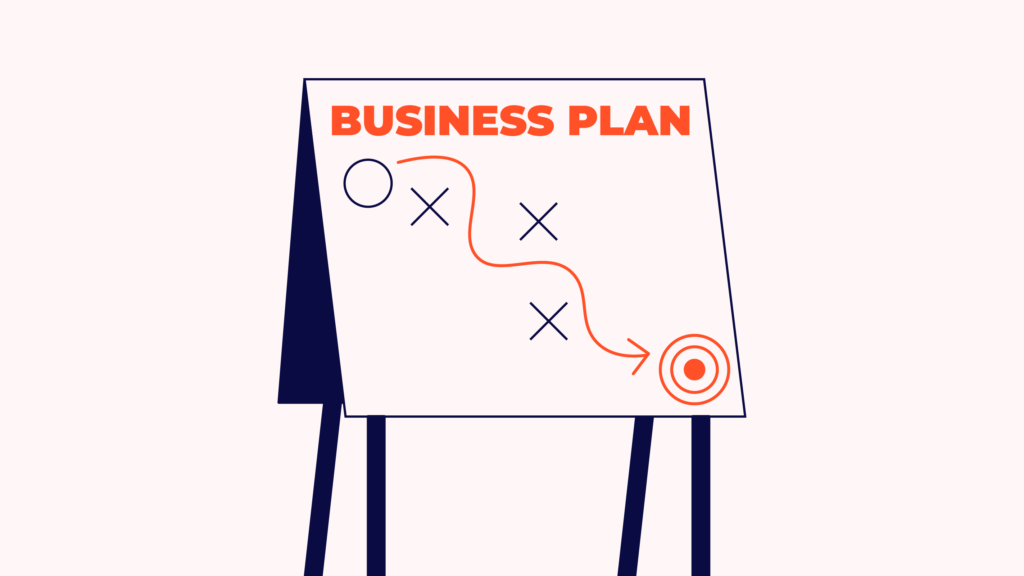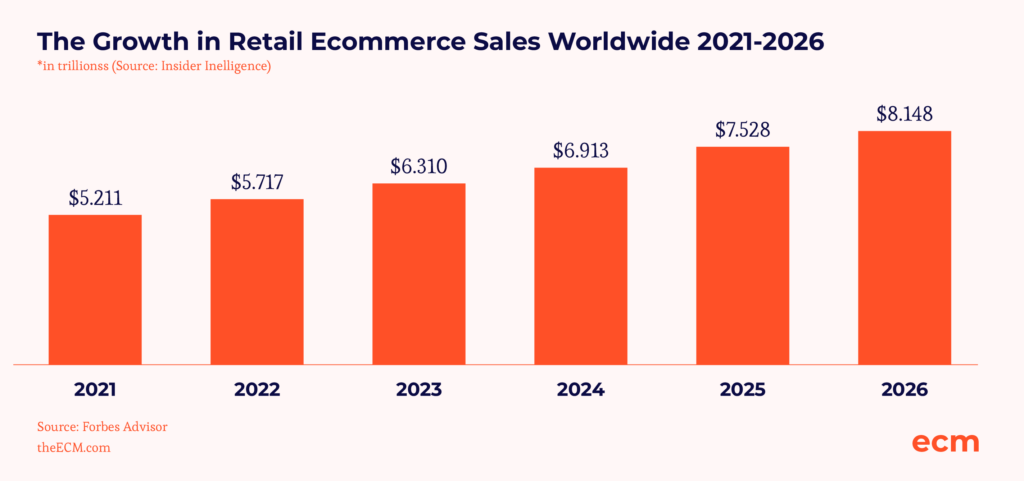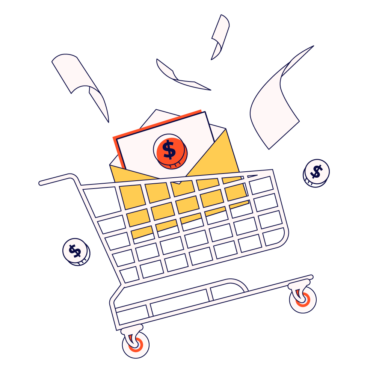Ecommerce is rapidly growing around the world. The industry has reached a market valuation of $6.31 trillion worldwide and is expected to cross $8 trillion by 2026.
In 2023, ecommerce accounted for 20.8% of all retail sales. The contribution of ecommerce is expected to grow even further to cover 24% of retail sales in 3 years. This seems like a good time for anyone thinking about starting an ecommerce business. Despite many companies enjoying pieces of this $6 trillion pie, starting an online store is not a piece of cake.
As with any other business, you need research and careful planning before jumping into action. That’s exactly what this guide is about. I will shed light on some basic business concepts, discuss examples, provide insights with statistics, and give you ready-to-use templates for various stages. But first, let’s begin with the fundamentals.
What Is An Ecommerce Business Plan?
An ecommerce business plan is a document containing the roadmap for initiating, maintaining, and expanding an online selling company. This document contains several details that are crucial for establishing your ecommerce business. It serves to guide the formation of a company and draw insights to make business decisions to achieve short-term and long-term goals.
The ecommerce business plan also contains information about the market, competitors, products, pricing strategy, company finances, supply requirements, etc. The more details you can add to an ecommerce business plan, the better you can execute it.
Why Do You Need An Ecommerce Business Plan?
An ecommerce business plan acts as a guiding document for your online business. It is a more systematic approach to analyzing the market and developing a business that can thrive amidst the competition.
This document also gives insight into your business model. The document covers several aspects of the company. It helps you define business goals for marketing strategy, operations, and finances. This plan also helps you understand how these aspects would affect each other.
For instance, you can gauge the impact of marketing expenses on the cash-flow statement. You can derive these insights from market research and financial plan sections of your business model.
It is also a necessity if you seek funding for your online store. Potential investors would gauge the feasibility of the company based on this document. The business plan gives them insight into the business strategy. It also presents a compelling case for the funds you demand.
Ecommerce entrepreneurs can showcase the operations plan and budget allocation for running an ecommerce store successfully. But most importantly, it shows value proposition to the potential investors. It gives them an idea of how the company will generate revenue, brand value, equity, etc.
How To Create The Perfect Ecommerce Business Plan
Let’s look at the step-by-step process for creating an ecommerce business plan. Each of these stages will help you get a deeper understanding of your business. It will also help you define your vision through organizational structure and processes. Let’s begin with the executive summary.
Step 1: Draft an executive summary
Although this is the first part of an ecommerce business plan, it is better to tackle the executive summary after completing the entire document. The executive summary gives an overview of the business plan on a single page.
The executive summary presents a company overview and highlights of the most important parts of the document. It gives a brief overview of what the new business is about and what it sets out to achieve. You will discuss these points in-depth later in the document. You can use the below template to draft your executive summary:
| Executive Summary | |
| Mission Statement: | What is the purpose behind the company’s existence? |
| Company History: | What are the company's roots, and how are they relevant to the planned venture? |
| Leadership Model: | Who is leading the company, and what are their qualifications for the role? |
| Company Stakeholders: | Who are the current stakeholders of the company? |
| Market Segment: | Which market segment does the company serve? |
| Ecommerce Products: | Which products will the company sell? |
| Ecommerce Services: | What are the services that the company will provide to its customers? |
| Unique Selling Points: | How are the products or services unique in the market? |
| Competitive Advantages: | How does the company’s offering compare against competitors in the market? |
| Suppliers & Vendors: | What kind of products or services will the company need from external parties? |
| Financial Projections: | What will be the financial standing of the company in the future? |
| Investments: | What are the resources the ecommerce business will need, and how much do they cost? |
| Company Goals: | What is the goal of the company in the long run? |
You will have better clarity regarding some of these aspects after you complete the entire ecommerce business plan. For instance, you can provide a more accurate competitive analysis after conducting market research. Similarly, you will have a clear understanding of financial projections and investment requirements after you source potential suppliers.
You can create a rough draft of the executive summary at the beginning. Then you can circle back to it when you have more clarity.
Step 2: Company description
In this section, you provide details regarding the company. At this point, the ecommerce business plan begins to take shape. Start filling out the details in the template below to describe your company.
| Company Description | |
| Company Purpose | What will the company do? How does it help the target customer? Why do you think the company will succeed? |
| Core Values | What are the core values that the company will uphold with regard to customer services, operations, and employee management? |
| Organizational Structure | What roles will the company need to run its operations? |
| Company Location | Where will the company set up its office? |
| Existing Resources | What are the resources the company already has? |
| Required Resources | What resources does the company need to be operational? |
In this section, you will start to define what your company will look like and what it will do. You will also provide details regarding the type of people you will need to run the company. You will also define the resources you already have to run the ecommerce business and the ones you will need.
For instance, if you have already purchased a domain name and registered the company name as a trademark. Then you can list it as an existing resource. But you have not developed an ecommerce website. So you will list website development under the required resources.
This section of your business plan also gives an overview of the hierarchy and the management team. You will show the number of departments in the company and the key team members for each department. You can also define the operations you will carry out in-house and those you will outsource to external ecommerce agencies.
This section will give you a clear idea of your current standing. It will also help you identify the things you are lacking. But this section, too, is subject to change. You might discover some additional requirements after additional research.
Step 3: Describe your products and services
In this section, you will define details about the products and services your ecommerce business will offer. You will describe what you are offering to your customers. It includes both products and services. You can use the ecommerce business plan template below to define these aspects.
| Products and Services | |
| Product Offerings | |
| Product Name | Product Attributes |
| Features | |
| Benefits | |
| Uses | |
| SKU Variations | |
| Cost of Manufacturing | |
| Price | |
| Service Offerings | |
| Service Name | Service Attributes |
| Service Provider | |
| Features | |
| Benefits | |
| Cost of Service | |
| Price | |
| Pricing Strategy | |
| Product Name | Pricing Strategy |
| Profit Margin | |
While you would only sell products on your ecommerce platform, you must also provide a few services. These would include order fulfillment systems, customer support, online transactions, and so on. You may only facilitate some of these services by yourself.
For instance, you may use a payment gateway for online transactions. Similarly, you might partner with a courier service to deliver the products to your customers.
Step 4: Conduct market analysis
This is the most important part of making an ecommerce business plan. You must analyze several factors concerning the market segment, competing brands, and competitor products.
You must understand how your products, services, and brand perception compares against the competition. Use the template below to create a detailed overview of the market you will compete against.
| Market Analysis | |
| Target Market | |
| Target Audience | What kind of people are likely to become your customers? |
| Buyer Persona | Create a detailed profile based on different target audiences |
| Customer Needs | What customer needs does your ecommerce fulfill? |
| Customer Pain Points | What customer pain points does your company resolve? |
| Customer Locations | Where are your customers located? |
| Competitor Analysis | |
| Competitor A | Competitor Name |
| Market Positioning | |
| Strengths | |
| Drawbacks | |
| Similarities | |
| Differences | |
| Marketing Channels | |
This analysis will affect several other aspects of your ecommerce business plan. At this stage, you must analyze the market and decide what place your company can take in the competitive landscape. You can also use other methods for market research, such as SWOT analysis or Porter’s Five Forces analysis.
Regardless of the method, you need an accurate understanding of what your competitors offer and how you can differentiate your ecommerce brand. This brings us to marketing.
Step 5: Draft your marketing plan
The marketing plan for an ecommerce business primarily depends on two factors. These are the target audience, customer segmentation, and market forces. You will draw relevant insights from the market analysis to define your marketing plan. Here is a template to help you define the marketing strategy for your online store.
| Marketing Plan | |
| Brand Positioning | How would you position your brand in the market so that it differs from the competition? |
| Audience Segment 1 | Relevant Products |
| Demographics | |
| Psychographics | |
| Locations | |
| Interests | |
| Purchase Drivers | |
| Product Uses | |
| Product Positioning | |
| Acquisition Channels | Which marketing channels will you use for reaching and acquiring new customers? |
| Channel 1 | Channel Attributes |
| Content Formats | |
| Sales Funnel Stages | |
| Target Audience Segments | |
| Audience Behaviour on the Channel | |
| Campaign Types | |
| Technology | What are the necessary tools to run your ecommerce marketing? |
| Tool 1 | Tool Attributes |
| Tool Uses | |
| Connected Marketing Channels | |
| Pricing Format (free/purchase/subscription) | |
Your marketing plan should give you a clear idea of how you will position your brand in the market. You also need to define the channels you will use for different stages of the sales funnel. For example, you can show that you will use Facebook ads to raise awareness and email marketing to engage existing customers.
You can also present additional sections to define your ideal customers using buyer persona. You can create a different persona for different types of potential customers. You can associate each persona with a product and its use cases. Finally, you need to define the ecommerce tools you will need for your marketing efforts. These can be automation tools, CRM software, SEO tools, etc.
Once you have a clear idea of how you will bring the audience to your ecommerce, you have to define how you will convert them into customers. That brings us to the next stage of the ecommerce business plan.
Step 6: Define sales and customer service processes
At this stage, you will define several aspects concerning your customers. These include purchase journeys and after-sales services. This strategy serves as an extension of the marketing plan. See the template below to define your sales and customer service strategy.
| Sales and Customer Service | |
| Ecommerce Sales | Sales Methodologies |
| After Sales Services | |
| Prospecting Strategy | |
| Points of Sales | |
| Tools & Resources | |
| Inbound Sales Channels | |
| Outbound Sales Channels | |
| Transaction Method | |
| After Sales Communication | |
| Sales Team Structure | |
| Customer Service | Stages of Customer Communication |
| Channels of Communication | |
| Tools & Resources for Customer Service | |
| Customer Support Team Structure | |
With this template, you are essentially defining customer experience with your brand. You will create a strategy for selling the products on different channels. These include ecommerce websites, marketplaces, affiliate websites, social media, etc. You will have to define the sales process for each channel.
You must also draft a plan to create memorable customer experiences. This is crucial for developing a community. It also has a direct impact on sales and revenue. Repeat customers spend 67% more than first-time buyers. Once you have a strategy for acquiring customers, you must build a strategy for delighting and retaining customers.
Step 7: Create a supply chain strategy
The supply chain strategy includes the journey of the product from the supplier to the customer. It includes procurement, manufacturing logistics, warehousing, distribution, order fulfillment, and reverse logistics. Use the template below to create your supply chain strategy.
| Supply Chain Strategy | |
| Procurement Strategy | Where do your products come from? |
| Procurement Source 1 | Supplier / Manufacturer Name |
| List of Products Sourced | |
| Supply Volume | |
| Price per Unit | |
| Logistics Strategy | |
| Supply Lead Time | |
| Warehousing Strategy | How will you manage the procured inventory? |
| Inventory Volume | |
| Warehouse Size | |
| Warehouse Locations | |
| Target Markets for Order Fulfillment | |
| Inventory Management Strategy | |
| Inventory Replenishment Strategy | |
| Logistics and Distribution Strategy | How will you move the products through the supply chain? |
| Logistics Vendors | |
| Stages of Inventory Movement | |
| Modes of Freight Transportation | |
| Inventory Distribution Strategy | |
| Order Fulfillment Strategy | |
| Reverse Logistics Strategy | |
| Cost of Logistics | |
In this section of the ecommerce business plan, you will outline how the product will make its way to the customer. Supply chain management involves everything from sourcing the products from a supplier to shipping the products to the customer.
Alongside the strategy, you also need to define the stages that you will outsource. Creating your supply chain is quite resource intensive. That is why ecommerce businesses outsource certain aspects to 3PL companies. Some of the commonly outsourced services include distribution and logistics (42%), manufacturing (37%), product finishing (29%), and packaging (23%).
This process accounts for a significant portion of ecommerce expenses. It will also impact several customer-facing aspects of the business. This includes the availability of stock, shipping charges, delivery time, and more. Hence, you should define a supply chain strategy for speed, efficiency, and cost-effectiveness.
Step 8: Identify legal frameworks
In this section, you will also cover the applicable legal frameworks for running the ecommerce business. These include business registration, taxation, permits, legal structure, trade laws, etc. Use the template below to define the legal obligations in your ecommerce business plan.
| Legal Frameworks | |
| Legal Considerations | What are the legal and compliance obligations of the company? |
| Business Registrations | |
| Product Registrations | |
| Trade Permits | |
| Product Licenses | |
| Relevant Regulatory Bodies | |
| Applicable Business Taxes | |
| Applicable Sales Taxes | |
| Insurance Requirements | |
You must understand the laws applicable to running an ecommerce business in your region. If you plan to ship products internationally, you must also understand international shipping laws, customs clearance requirements, import/export regulations, and trade laws in the target market. This section ensures that your company always remains on the right side of the law.
Step 9: Define financial requirements
The final section of an ecommerce business plan is concerned with finances and legal compliances. The preceding sections will give you estimates regarding different aspects of your ecommerce business. These include operations, marketing, procurement, logistics, and so on.
Based on these estimates, you will define the financial projections for your ecommerce business. This includes both revenue and expenses. You can use the template below to define the financial aspects of your business.
| Financial Considerations | |
| Startup Cost | How much funds will you need to start the ecommerce business? |
| Total Cost | |
| Budget Breakdown | |
| Operational Cost | What is the annual budget required to run the business? |
| Total Cost | |
| Budget Breakdown | |
| Sales Forecast | How many products will the company sell each year after initiating? |
| Sales Estimate | |
| Profit Margins | |
| Annual Revenue Estimates | |
| Break Even Analysis | How long will it take for the company to recover the investment? |
| Year-on-Year Growth Estimate | |
| Year-on-year Cost Estimates | |
| Estimated Break-Even Point | |
| Profit and Loss Analysis | |
If you pitch the ecommerce business plan to an investor, you must add other details to this section. These would include funding requirements, funding stages, value offerings, etc. This section of your business plan also sheds light on a company’s assets and liabilities.
You must also clarify what you offer the investors against the funds. This can be equity stake, debt, dividends, and so on. This helps potential investors conduct a cost-benefit analysis.
You can go a step further and present key elements of cost-benefit analysis for the ecommerce company. This should highlight the short-term and long-term gains for the new business. You can use this section to show potential investors how your new business will grow in market value based on milestones. These milestones can be defined based on sales, inventory size, revenue, market acquisition, etc.
With this section, you conclude your ecommerce business plan. You need to revisit the executive summary and ensure it aligns with the rest of the document. It is best to review the entire document a few times to ensure you present a unified vision for starting and running your ecommerce business.
FAQs
Is ecommerce a profitable business?
The profitability of ecommerce businesses depends on several factors. This includes market condition, business structure, product demand, revenue model, etc. You can understand the profitability of your ecommerce business idea by checking brands selling similar products. When first starting out, you can cut costs by leveraging tools like free inventory management software. This can help ease the financial burden of being a new business.
Do I need a business plan for an ecommerce business?
A business plan gives structure to an ecommerce business idea. It is a really helpful document for business owners and entrepreneurs. This document helps you measure the viability of the business model, products, marketing strategy, financial plan, legal structure, operations, and other aspects of the company.
Use The Ecommerce Business Plan to Guide Your Actions
The purpose of creating an ecommerce business plan is to represent your vision systematically. This document will shed light on several aspects of your ecommerce business idea. It will also serve as a guide, philosopher, and friend when you launch your company.
If you are pitching your idea to investors, this document will show them the value that your ecommerce business idea can generate for them. The next step for you is to turn the ecommerce business plan into a company.
You should subscribe to The Ecomm Manager newsletter for more news, trends, tips, and guides related to ecommerce. These articles can help you optimize and expand your business further.
More great ECM content:
- Ecommerce Platform Guide: How To Choose The Right Solution For Your Business
- How To Use Ecommerce Accounting Software To Maximize Your Money: Methods, Tips & Tools
- What Is Order Management?
- A Guide To The Global Order Fulfillment Process
- An Easy Guide To Ecommerce Shipping: Process, Strategies, Methods & Costs
- Ecommerce Warehouse Process Guide: Expert Tips & Advice for Success
- 26 Types Of Marketing Software And What They Do
- How to Start a Subscription Box: A Step-by-Step Guide for Ecommerce
ECM recommends:



